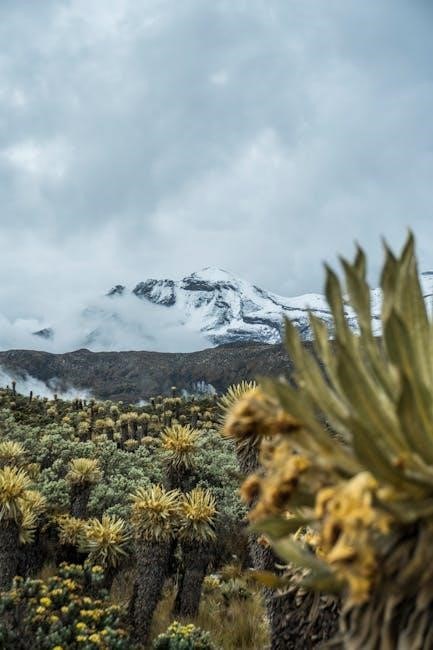Wilderness medicine involves providing medical care in remote, resource-limited environments with delayed evacuation. It requires unique skills to manage injuries and illnesses in unpredictable settings, emphasizing improvisation and prevention to ensure survival and well-being.
Definition and Scope of Wilderness Medicine
Wilderness medicine is a specialized field of healthcare focused on providing medical care in remote, resource-limited environments where access to advanced facilities is unavailable. It involves managing injuries, illnesses, and environmental exposures in settings like forests, mountains, or deserts. The scope includes improvising treatments with limited supplies, preventing illnesses, and adapting to unpredictable conditions. Practitioners must possess a unique blend of medical knowledge, survival skills, and environmental awareness to address diverse challenges, from trauma and infections to altitude sickness and extreme weather-related illnesses.
Importance of Wilderness Medicine in Remote Areas
Wilderness medicine is crucial in remote areas where access to healthcare facilities is limited. It enables individuals to provide immediate care for injuries and illnesses, preventing minor issues from escalating. The ability to improvise treatments with available resources is vital, as delays in medical attention can lead to severe outcomes. Wilderness medicine also emphasizes prevention, teaching individuals to avoid risks and recognize early signs of illness. This specialized knowledge ensures that healthcare providers and outdoor enthusiasts can effectively manage medical situations in challenging environments, ultimately saving lives and maintaining health in remote and resource-limited settings.

Preparation for Wilderness Medical Emergencies
Preparation is key to managing wilderness medical emergencies, requiring a well-stocked kit, proper training, and understanding of environmental risks to ensure effective and timely care.
Essential Gear for a Wilderness Medical Kit
A well-equipped wilderness medical kit is crucial for managing emergencies. It should include bandages, antiseptics, pain relievers, blister care, and tools like scissors, tweezers, and gloves. Incorporate splints for fractures, wound closure strips, and medications for allergic reactions. Don’t forget hydration supplies, thermal blankets, and a first aid manual. Personal protective equipment (PPE) like masks and eye protection is also vital. Ensure all items are durable, lightweight, and easy to use in challenging environments. Regularly update and customize the kit based on the group size, terrain, and potential risks.
Skills and Training for Wilderness First Responders
Wilderness first responders require advanced training to handle remote medical emergencies. Key skills include trauma care, wound management, and fracture stabilization. Training emphasizes environmental hazard awareness, such as altitude sickness and hypothermia. Responders must master communication techniques for coordinating evacuations and navigate using GPS and maps. Practical experience in simulated scenarios builds confidence and decision-making abilities. Certification programs, like Wilderness First Responder (WFR), teach improvisation with limited resources and stress management. Continuous education ensures responders stay updated on best practices, enabling them to provide effective care in isolated, unpredictable settings.

Common Wilderness Injuries and Their Management
Common injuries include wounds, fractures, and burns, often requiring immediate care. Proper management involves cleaning, stabilizing, and preventing infection, with resourcefulness and knowledge being essential in remote settings.
Wound Care in the Wilderness
Wound care in remote settings requires immediate attention to prevent infection. Assess the wound for debris and bleeding, then clean with sterile or potable water. Debride damaged tissue if necessary, and apply antibiotic ointment. Cover with a sterile dressing to protect from contaminants. Monitor for signs of infection, such as redness or swelling. Elevate the affected area to reduce swelling. Change dressings daily or when soiled. Use topical antibiotics judiciously to avoid resistance. If infection develops, seek evacuation for advanced care. Proper wound management is critical to prevent complications in resource-limited environments.
Fracture Management in Remote Settings
Fracture management in remote areas requires immediate stabilization to prevent further injury. Assess alignment, circulation, and nerve function. Immobilize with splints or improvised materials like padded sticks or inflatable splints. For femur fractures, consider traction splints to reduce pain and displacement. Monitor for compartment syndrome or nerve damage. Administer pain relief cautiously, avoiding overdoses. Elevate the affected limb to reduce swelling. Reassess periodically and adjust immobilization as needed. Prepare for evacuation to a medical facility for definitive care. Proper management prevents complications and promotes recovery in austere environments.
Preventing and Treating Infections
Preventing infections in the wilderness is critical due to delayed medical care. Clean wounds thoroughly with sterile water and antiseptic wipes to remove dirt and bacteria. Apply antibiotic ointment to reduce infection risk and cover wounds to keep them dry. Monitor for signs of infection, such as redness, swelling, or pus. If infection develops, drain abscesses carefully and change dressings frequently. Administer antibiotics judiciously, only when clear signs of infection are present. Manage pain with over-the-counter medications like ibuprofen. Educate patients on proper wound care to avoid complications and know when evacuation is necessary for advanced treatment.

Medical Emergencies in the Wilderness
Medical emergencies in remote areas require immediate recognition and care, focusing on stabilizing the patient and preventing deterioration until evacuation or advanced help is available.
Cardiovascular Emergencies
Cardiovascular emergencies, such as heart attacks or strokes, are critical in wilderness settings due to limited resources. Recognition of symptoms like chest pain, shortness of breath, or neurological deficits is crucial. Immediate care includes rest, pain management, and administering aspirin if available. Wilderness first responders must prioritize stabilization and rapid evacuation to a medical facility. Hypothermia or altitude sickness can exacerbate cardiac issues, requiring prompt recognition and treatment. Proper training in CPR and Automated External Defibrillator (AED) use is essential for improving survival rates in remote areas.
Altitude Sickness
Altitude sickness occurs when the body cannot adapt to high altitudes, leading to symptoms like headaches, nausea, and fatigue. It is categorized into mild, moderate, and severe forms. Mild cases can be managed with rest and hydration, while moderate cases may require descent to lower altitudes. Severe altitude sickness, characterized by confusion or difficulty breathing, is life-threatening and demands immediate evacuation. Preventive measures include gradual ascent, staying hydrated, and avoiding overexertion. Recognizing early signs is crucial to prevent progression and ensure safe outcomes in high-altitude environments.
Allergic Reactions and Anaphylaxis
Allergic reactions in the wilderness can range from mild discomfort to life-threatening anaphylaxis. Symptoms include itching, swelling, difficulty breathing, and rapid heartbeat. Anaphylaxis requires immediate intervention with epinephrine auto-injectors. Administering the injection and seeking urgent evacuation are critical steps. Prevention involves carrying personal medications, avoiding known allergens like certain plants or insect bites, and educating team members on recognition and response. Delayed treatment can lead to severe complications, making prompt action essential for survival in remote areas with limited medical resources.

Environmental Hazards and Their Medical Implications
Environmental hazards such as extreme weather, wildlife encounters, and toxic exposures pose significant risks in wilderness settings, requiring specialized knowledge to prevent and treat related medical conditions effectively.
Weather-Related Illnesses
Weather-related illnesses, such as hypothermia, heat stroke, and frostbite, are common in wilderness settings. Hypothermia occurs when body temperature drops below 95°F, often due to cold exposure. Heat stroke happens when the body overheats, typically in high temperatures with inadequate hydration. Frostbite results from freezing tissues, affecting extremities first. Prevention involves layering clothing, staying dry, and monitoring weather conditions. Early recognition of symptoms, such as shivering, confusion, or numbness, is critical. Treatment requires gradual rewarming or cooling, depending on the condition. Prompt intervention is essential to avoid severe complications or fatalities in remote areas with limited medical resources.
Wild Animal Encounters
Encounters with wild animals, such as bears, snakes, or large predators, pose significant risks in wilderness environments. Prevention includes making noise while hiking, carrying bear spray, and staying informed about local wildlife. If attacked, knowledge of species-specific defensive techniques is crucial. Injuries may require immediate first aid, such as wound cleaning to prevent infection. Recognizing signs of envenoming or rabies is essential for timely medical intervention. Understanding how to avoid and manage these encounters is critical for safety in remote areas, where medical help may be delayed or unavailable. Preparedness and awareness are key to minimizing risks and ensuring survival.
Rescue and Evacuation Techniques
Wilderness rescue involves signaling for help, navigating terrain, and safely transporting patients to medical care, requiring teamwork, communication, and adaptability to ensure successful evacuation in remote settings.
Signaling for Help
Signaling for help is critical in wilderness emergencies to alert rescuers or passersby. Use reflective surfaces, mirrors, or flares to create visible signals during the day. At night, fires or LED lights can be effective. Whistles are essential tools; international distress signals include three short blasts. Create large, visible markers using rocks or logs to form SOS or other recognizable patterns. Stay visible by wearing brightly colored clothing or attaching reflective tape to gear. Consistent signaling increases the likelihood of being noticed, while random or intermittent signals may be overlooked. Preparation and awareness of signaling techniques are vital for survival in remote areas.
Evacuation Strategies
Evacuation strategies in wilderness medicine focus on safely transporting patients to medical care while minimizing further harm. Assess the patient’s condition to determine the urgency and method of evacuation. Use stretchers or makeshift litters for immobilization, ensuring proper spinal alignment. Consider environmental factors like terrain, weather, and available resources. Team coordination is crucial; assign roles to maintain efficiency. If possible, use mechanical aids like pulleys or ropes for difficult terrains. Always prioritize patient safety and stability during movement. Effective evacuation planning prevents further injury and ensures timely medical intervention, balancing speed with caution to protect both the patient and responders.
Legal and Ethical Considerations
Wilderness medicine involves unique legal and ethical challenges, such as patient autonomy, resource allocation, and liability concerns, requiring practitioners to balance care with practical limitations in remote settings.
Liability in Wilderness Medicine
Liability in wilderness medicine refers to the legal risks faced by practitioners providing care in remote settings. Lawsuits can arise from alleged negligence or failure to meet standards of care. The unique challenges of wilderness environments, such as limited resources or delayed evacuation, may influence legal outcomes. Practitioners must balance ethical obligations with practical limitations, ensuring reasonable care under the circumstances. Documentation of decisions and actions is crucial to mitigate liability risks. Understanding local laws and maintaining appropriate training can help providers navigate these complexities, fostering a culture of responsible and compassionate care in challenging situations.
Ethical Dilemmas in Remote Care
Ethical dilemmas in remote care arise when practitioners face challenging decisions with limited resources. These situations often involve balancing patient needs, available treatments, and environmental constraints. Privacy concerns, informed consent, and resource allocation are common issues. Practitioners must weigh the benefits and risks of interventions, considering the patient’s autonomy and the greater good. Cultural sensitivity and respect for local practices also play a role. Ethical frameworks guide decision-making, emphasizing compassion, fairness, and transparency. Training in ethical principles helps providers navigate these complex scenarios, ensuring care that is both effective and morally sound in remote settings.
